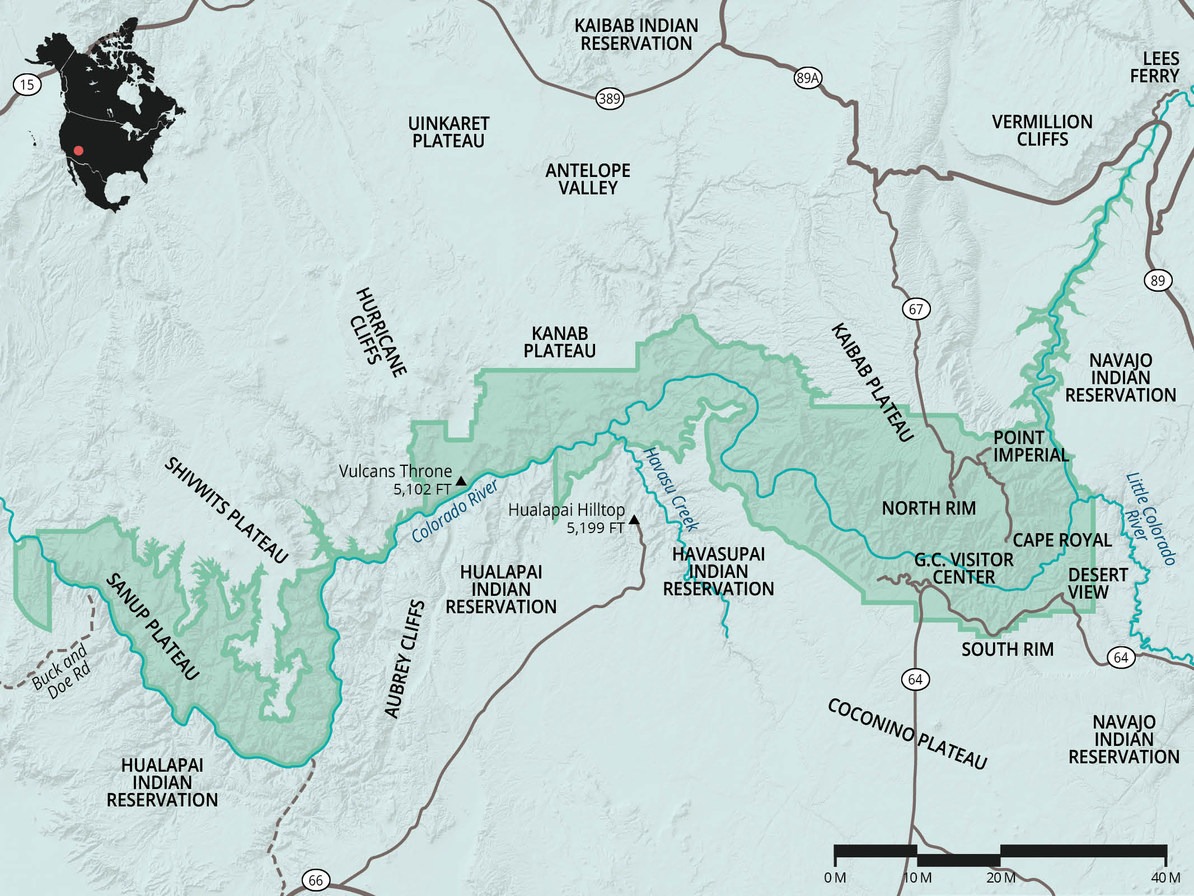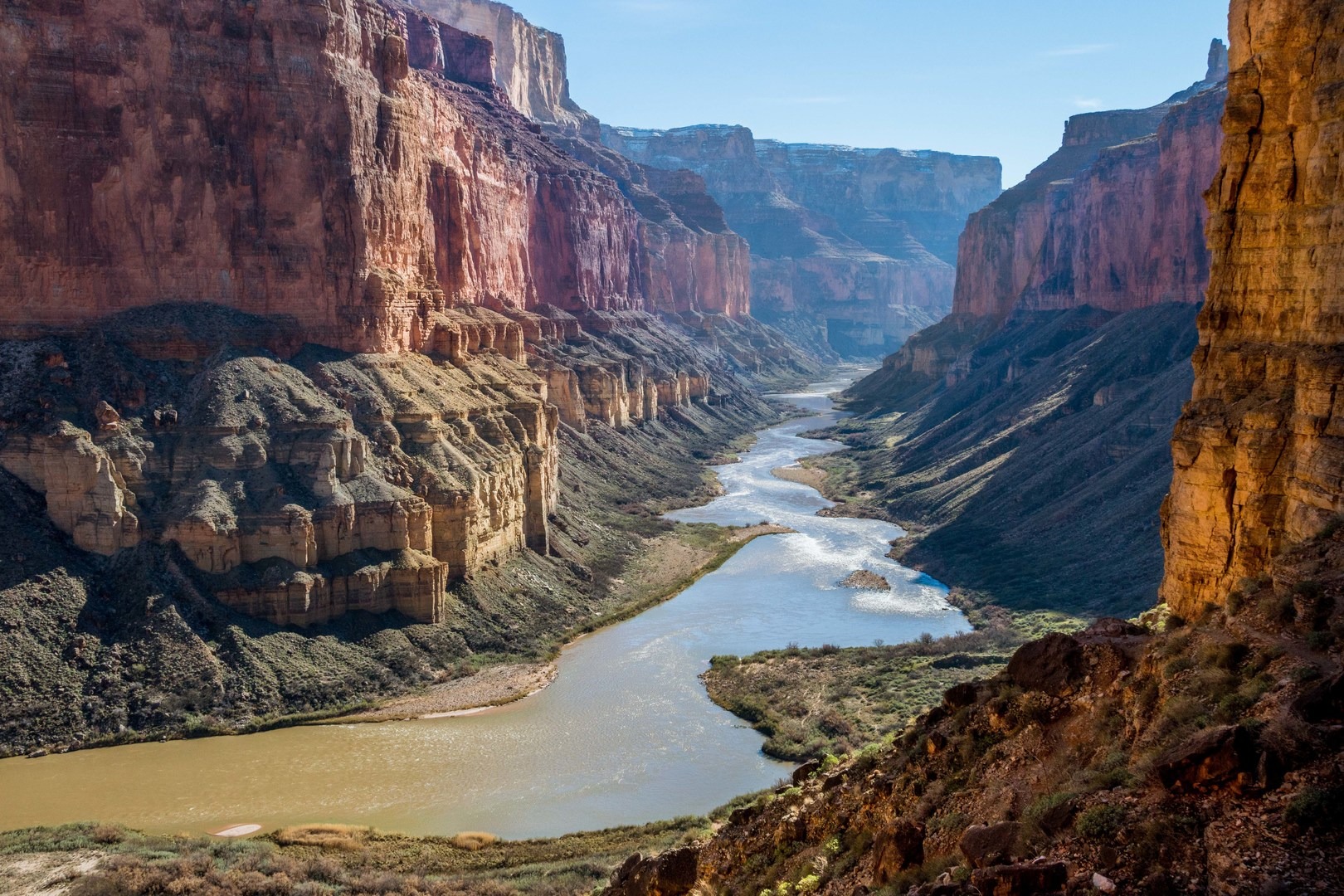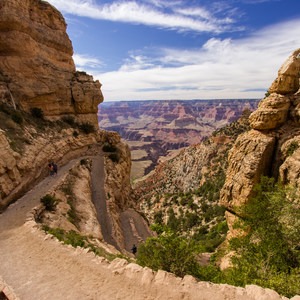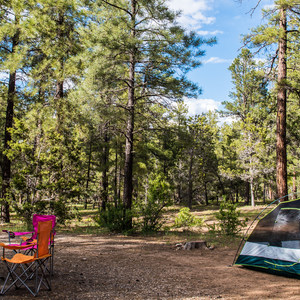You are here
Grand Canyon National Park Overview | South Rim | North Rim | Hiking | Backpacking | Mule Trips | River Trips | Weather | Pets | Havasupai
Grand Canyon National Park Overview

A gouge in the Earth more than a mile deep, 277 miles long, and 18 miles wide, the Grand Canyon is clearly visible from space but practically undetectable from anywhere in the plains or pine forest surrounding it until you emerge suddenly on the edge of the vast abyss. This precipitous chasm is a gorge of the Colorado River, which begins high in the Rocky Mountains and drains into the deserts, where it has carved through erodible sand and stone. Of the deep gorges that furrow the face of the Southwest's Canyon Country, the Grand Canyon is king of them all. Cutting a giant rift across a tectonic uplift on the already elevated landmass called the Colorado Plateau, the Grand Canyon exposes eons of geologic history, including some of the oldest rocks on Earth. It is one of seven natural wonders of the world, a UNESCO World Heritage Site, and a jewel of the U.S. national park system.
At a maximum of 6,093 vertical feet (1,857 meters) from rim to river, the Grand Canyon is not the world's deepest canyon by official measurements. It is the most dramatic: While other record-holding canyons are defined by mountaintop to valley bottom slopes, the Grand Canyon is starkly defined by a relatively flat rim that suddenly falls away in tiers of vertical cliffs.
A place revered since antiquity, these rock walls house countless Native American artifacts and places still held sacred by indigenous cultures. Europeans first saw the canyon in 1540 during Spanish exploration, but non-natives didn't see it again until American settlers arrived in the 1800s. Early explorers saw it as a wasteland and a barrier to westward expansion, but by the time of John Wesley Powell's famous Colorado River expedition in 1869, he and scientists of the time recognized its geological singularity and value as a natural wonder. Theodore Roosevelt later called it "the one great site which every American should see." He designated it a national monument in 1908, and it became a national park in 1919.
Today, just as in ancient times, the canyon is so much more than just a spectacle. It is a world all its own waiting to be explored. Beneath the rim are infinite microcosms of environment perched on the edge of precipitous cliffs, poised at the interface of fractured rock and flowing water, placed at the paradox of harsh desert and lifeblood river.
Overlooking the Grand Canyon from the top quite literally only scratches the surface of this breathtaking landscape. Not everyone wants to go deeper, but whether venturing below the rim or not, the national park offers endless possibilities, from an afternoon of sightseeing to a lifetime of adventure. Use this guide to plan your trip and maximize your experience in Grand Canyon National Park.
South Rim
Most people who visit the Grand Canyon only see it from the South Rim simply because it is easily accessible from the interstate and open year round, unlike the North Rim. Thus, South Rim has the most popular viewpoints, trails, and other attractions. There is also a free shuttle service to aid parking and transportation. As opposed to North Rim, it is the better choice for those seeking convenience, roadside overlooks, and lots of options for activities like dining, entertainment, and museums. It is also the better destination for hikers who want to explore below the rim, because there are numerous route options.
Overlooks
The South Rim has many named overlooks that are easily accessible from the road. You could spend a whole day seeing them all. Here are the top recommendations, organized from east to west.
- Desert View: A phenomenal vantage over the eastern Grand Canyon and the Painted Desert, and also one of the broadest views across to the North Rim. This site includes the historic and incredibly aesthetic Desert View Watchtower, which you can climb for an elevated perspective through its windows.
- Lipan Point: One of the widest and deepest panoramas of the canyon. This spot is perfect for sunrise or sunset. It is a short spur drive from the main road, which keeps some would-be crowds away.
- Grandview Point: There are great views from the overlook near the parking lot, or even better views accessed by hiking a very short distance down Grandview Trail to one of the rock outcrops. From there you can see bends in the Colorado River below and the outline of Desert View Watchtower above. Get here early for an incredible sunrise.
- Yaki Point: Accessible only by shuttle, Yaki Point overlooks the South Kaibab Trail and a huge view of the canyon. Time the shuttle ride carefully and you can catch sunrise or sunset.
- Mather Point: The most popular overlook by far, this one is right next to the visitor center and main parking area. The crowds are no excuse not to see it, however, because the view is classic for good reason.
- Yavapai Point: This site provides a unique perspective over the Inner Canyon and is also the site of the extremely informative Yavapai Geology Museum.
- Lookout Studio: An elegantly quaint historic building set at one of the best canyon vistas, this studio hosts observation deck with telescopes available.
- Hopi Point: This point is one of the most-photographed spots for sunrise and sunset.
- Mohave Point: A similar vista to Hopi Point, but offering a slightly different westward angle and view of the river, Mohave Point is especially good at sunset.
- The Abyss: From here you can stare down the greatest uninterrupted vertical drop anywhere on the South Rim, the 3,000-foot sheer face aptly named The Abyss.
- Pima Point: Near the far end of Hermit's Rest Road, Pima Point gives a view farther to the west than the others, offering a glimpse of a different part of the canyon.
Trails
- Rim Trail: The only trail that does not drop below the rim on this side of the park, Rim Trail is the place for a casual stroll. It connects all the viewpoints and buildings along the rim, giving various options for hiking distance. Most of it is flat and paved, making it great for kids, strollers, wheelchairs, and dogs.
- South Kaibab Trail: The South Kaibab Trail is the most scenic trail on South Rim and one of two corridor trails. This route is the shortest and steepest to the bottom of the canyon, following an exposed ridge sharply down into the canyon's heart. A short out-and-back makes a memorable day hike, and overnight trips allow for deeper exploration.
- Bright Angel Trail: More moderate than South Kaibab in steepness and exposure, but still a very grueling hike, Bright Angel is the other corridor to the Colorado River. This trail offers more options for day hike and overnight distances, including a shady rest area and campground halfway down.
- Grandview Trail: Entering the eastern part of the canyon and earning very different views than the corridor trails, Grandview is a great alternative for day or overnight hikes. It descends to Horseshoe Mesa, a steep-sided plateau in the middle of the canyon where the ruins of an old copper mine remain.
- Hermit Trail: The main trail in the canyon's western region, Hermit Trail is a more rugged option for descent. It enters a steep side canyon before making its way eventually down to the river and some tranquil backcountry campsites. A somewhat moderate day hike option is the spur trail to Dripping Springs and back.
- Tonto Trail: This trail runs along the Tonto Plateau, a gently sloped bench about halfway down into the canyon. All rim-to-river routes from South Rim cross this trail, so it can be used as a link to make a loop route or access different parts of the canyon.
Campgrounds
- Mather Campground: This campground is the top pick for most tent campers visiting the park. It is in Grand Canyon Village and therefore central to most destinations and amenities. Sites are reservation only, however, and do fill up fast.
- Desert View Campground: More rustic and less spacious than Mather, located some distance from most park attractions, is the campground at Desert View. These sites are first-come first-served only, so no reservations are available.
- Trailer Village: A concessioner-operated campground with RV hookups, Trailer Village is located next to Mather Campground in Grand Canyon Village.
- Ten-X Campground: Outside of the park, but still very close, is the National Forest campground Ten-X. It features spacious sites and a more relaxed atmosphere than those inside the park boundary. Some sites can be reserved.
Lodges
Western Grand Canyon Village, reserved through concessioner Xanterra:
- Bright Angel Lodge
- El Tovar Hotel
- Kachina Lodge
- Thunderbird Lodge
- Maswik Lodge
Eastern Grand Canyon Village, reserved through concessioner Delaware North:
- Yavapai Lodge
Additional hotels and lodges are located just south of the national park in the town of Tusayan, and others further away in Valle. More information on lodging in and around Grand Canyon can be found here.
North Rim
This is the park's other half, but it is visited by far fewer people. It is only open from May 15 to October 15, and it is quite remote compared to the South Rim. Driving between the two rims takes about 4.5 hours, and the North Rim is 3 hours from the closest interstate. Lodging and camping options are also more limited. For those with the time and motivation, however, this region of the park is the most rewarding because of its thinner crowds, cool summer temperatures, amazing hiking along the rim, and scenic driving through forests and meadows of the Kaibab Plateau.
Overlooks
- Bright Angel Point: A short hike hike near the visitor center that leads to an incredible view of the canyon and the Grand Canyon Lodge, Bright Angel Point is great for sunsets!
- Point Imperial: This roadside overlook is at the highest-elevation point along the rim, at 8,8003 feet. From here you look down into the very deepest part of the canyon, and outward to an incredible panorama of desert, forest, rock, and sky.
- Cape Royal Road Overlooks: Several impressive vistas and rewarding short hikes lie along this scenic drive.
Trails
- North Kaibab Trail: This is the single route to the bottom of the canyon from North Rim. Many people consider it the most beautiful trail in the whole park. Hikes of any length down and back are absolutely stunning, but difficult. Highlights include the Supai Tunnel, tightly stacked switchbacks, the Eye of the Needle cliff traverse, twin waterfalls of Roaring Springs, and the enchanting alcove of Ribbon Falls.
- Cape Final Trail: An indisputable highlight destination on the North Rim, this trail is easygoing through the forest to a breathtaking view into the heart of the canyon from Cape Final.
- Transept Trail: This is probably the most frequently traveled trail because it is a casual stroll near the main parking lot that connects the campground and visitor center. It traverses a side canyon known as the Transept that peeks out into the main canyon.
- Cliff Springs Trail: An easy and beautiful hike from Cape Royal Road, Cliff Springs Trail includes Native American ruins, pictographs, and a natural spring.
- Uncle Jim Trail: This trail is a popular loop hike on a wide trail that leads to huge views overlooking Roaring Springs Canyon, the main canyon, and North Kaibab Trail.
- Point Imperial Trail: Easy but less-frequented, this hike from Point Imperial through regenerating fire-scarred forest leads to a new perspective from Woolsey Point and eventually links with Nankoweap and Saddle Mountain Trails.
- Widforss Trail: This moderate hike is great for all around for views, nature, and exercise. The first half finds great overlooks of the Transept and offers a self-guided interpretive tour of an old-growth forest. The second half ventures deeper into the woods before popping out at the vista of Widforss Point.
- Ken Patrick Trail: As the least-traveled trail on the North Rim, Ken Patrick Trail is one for seekers of solitude and wilderness.
Campgrounds/Lodge
- Grand Canyon Lodge: This famous and historic lodge is the sole option for overnight stays other than camping on the North Rim. Rustic but charming accommodations in cabins or motel rooms are available near the main lodge with its grand dining hall and even grander views over the canyon. You must book far in advance.
- North Rim Campground: This is the only campground inside the park boundary on the North Rim. It is very close to the general store, visitor center, and trailheads. Reservations far in advance are strongly recommended.
- Jacob Lake Campground: A National Forest campground that is not in the national park but close enough to be a good option and has nice amenities. Some sites can be reserved.
- DeMotte Campground: Another National Forest campground, closer to the park entrance than Jacob Lake, but with fewer amenities. Some sites can be reserved.
- Kaibab Camper Village: A commercial campground with RV hookups located outside of the park at Jacob Lake.
Hiking
Hiking the Grand Canyon is a feat attracting challengers from all over the world. Very few landscapes deal with such steepness and sheer scale as the Grand Canyon. From casual hikers to overnight trippers to endurance athletes, everyone can find satisfaction here, and the arena is incomparable for scenic attraction. Preparation, caution, and discretion are essential because of the difficult environment. Terrain is not the only source of extremes here. Heat, cold, wind, and thunderstorms are all to be contended with depending on the season. Here are some basic tips for hiking and backpacking, but we recommend reading our thorough guide How to Hike the Grand Canyon: Tips for beginners and experts.
- Climbing out will take more time. Plan on your return trip to take about twice as long as the hike down. Take periodic breaks on purpose to eat and hydrate.
- Carry plenty of water and food. Eat and drink roughly twice as much as you would during a normal time span. Food is just as important as water for staying fueled and healthy, especially in the desert, so bring salty high-calorie snacks.
- Weather can be extreme. Weather is usually deceptively pleasant at the rim but heats up drastically as you descend. Lightning storms pop up suddenly in the summer. Winter brings snow and ice.
- Pack light and wear good shoes. Try to minimize weight, but don't skimp on essentials or emergency gear. Your load should be mainly water and food. Also, bring sun protection and extra layers if the weather may turn.
- Listen to your body. Be honest with yourself and use caution. The canyon is not a place to push your limits recklessly.
Backpacking
All camping below the rim requires a backcountry permit from the national park. These are available from the Backcountry Information Center on the South Rim or online, and in most cases they must be reserved in advance. There are a certain number of last-minute permits available for Corridor Zone campgrounds, but these can only be obtained at the Backcountry Information Center in person within one day of when you plan to start your hike. The fee is $10, plus $8 per person per night.
The most popular campgrounds are along the corridor trails of Bright Angel and North Kaibab. South Kaibab has no campgrounds, but other campgrounds are available elsewhere. At-large camping is also permitted throughout most areas of the canyon, but the general location must be specified on your permit.
Corridor Zone campgrounds all have designated sites, maintained trails, good signage, purified water stations, toilets, and ranger stations. They are as follows:
- Indian Garden: Along Bright Angel Trail, near South Rim
- Bright Angel: In the bottom of the canyon near Phantom Ranch and the junction of North Kaibab, Bright Angel, and South Kaibab trails
- Cottonwood: Along North Kaibab Trail, near North Rim
Threshold Zone campgrounds have designated sites, but unmaintained campgrounds, untreated and scarce/seasonal water sources, pit toilets nearby, and no other services. There are also Primitive Zone and Wild Zone camping areas for advanced hikers on complicated routes, which can be utilized with backcountry permits. Consult the Backcountry Information Office for more about these camping opportunities.
Mule Trips
The corridor trails (Bright Angel, South Kaibab, North Kaibab) can be traveled by mule, animal aids that have been a staple of Grand Canyon exploration since Westerners first began trekking to the bottom. If you prefer to see the Grand Canyon with one of the famous sure-footed mules, you can book a trip from the South Rim to stay overnight at Phantom Ranch in the bottom, or a short out-and-back day trip on North Kaibab Trail from the North Rim. Mule rides are best booked in advance.
River Trips
The Colorado River through the Grand Canyon is indisputably America’s most iconic wilderness whitewater expedition. Lore from “The Grand” pervades river culture around the world, and many a boatman dreams of his/her chance to row it. The rapids that thunder through Grand Canyon are legendary, so much so that they have their own rating of difficulty that is used nowhere else in the world (1-10 as opposed to I-V). Of course, the rapids are not the only highlight of a river trip.
Floating through the canyon is like a lifetime in an entirely different world sunk beneath the rim of reality and encapsulated in surreal beauty. The Grand Canyon is mind-bogglingly huge, and viewing it from the rim does hardly any justice to its full majesty. So many intricacies can only be realized from river level—by hiking into surprisingly expansive side canyons, squeezing into narrow slots, paddling turquoise tributary waters, and gazing up at massive rock walls. Experiencing the canyon from the bottom is not reserved for elite boatmen only, however. Commercial operations allow any paying customer to take a trip down the river, and an annual weighted lottery awards permits to private boaters to make the journey under their own guidance.
Weather
Elevation ranges from 1,200 feet at Lake Mead to nearly 9,000 feet on the Kaibab Plateau. This drastic gradient creates a startling diversity of environments that rarely occur in such proximity. There can be snowfall among spruce and fir on the North Rim while simultaneously the sun bakes on yuccas and cacti on the canyon floor. Most visitors will not encounter such extremes in one trip here, but all should be aware that the climate is far from the predictably sunny Arizona desert that one might imagine. Day/night fluctuations in temperature are often drastic in this dry air at high elevation, so expect to sweat during the day and bundle up at night.
Summer
Summer sees the most visitors but is not necessarily the best time to visit. High temperatures on the South Rim often reach 90 degrees and can exceed 110 in the bottom of the canyon. The North Rim stays cooler at its higher elevation, but the sun is still intense. Thunder storms are a constant threat during the monsoon season that stretches from July to September and brings rain, hail, wind, and lightning. Plan your day starting early to avoid midday heat and afternoon storms.
Fall
Autumn is a great season at the Grand Canyon, when the weather cools and dries. Nights can dip to freezing on the rim, but for the most part temperatures are comfortable. Weather can still change suddenly, however, with late monsoon or early winter patterns popping up occasionally.
Winter
Winter is a highly underrated time to visit the Grand Canyon. When the winter storms occur, snow, ice, and wind are more intense than many visitors to Arizona would expect. The majority of days are crisp, clear, and sunny, however, and snowy vistas are some of the grandest views to be had. The North Rim is not open at all from mid-October to mid-May because roads remain snowbound. The South Rim is more mild and open all year, but trails are usually icy for the duration of winter. Spikes or crampons are recommended for hiking below the rim.
Spring
Spring is another great time to visit, with mild temperatures and many sunny days, though the weather can be especially unpredictable during this transitions seasons. The South Rim gets intermittent wintry storms into March and even April. The North Rim can be snowy well into May. Spring is generally the windiest time of year throughout the canyon.
Pets
Dogs are not allowed on most trails in Grand Canyon National Park, and are forbidden anywhere below the rim. This rule is to avoid disturbing native wildlife, which would be deterred by dogs, and to preserve the experience of other human visitors to the canyon. Dogs are allowed on the Rim Trail and along all paved roads and walkways in the park as long as you always clean up after your pet. They must be kept on a leash no longer than six feet and never left unattended, even inside a vehicle. Summer heat can kill, so consider using the kennel service in Grand Canyon Village if you want to hike below the rim.
Havasupai
Havasu Falls and the other photo-famous cascades on Havasu Creek (Mooney Falls and Beaver Falls) are part of Grand Canyon, but are not within the national park. They are the homeland of the Havasupai people, an indigenous community that still lives in a village below the canyon rim. They subsist on these blue-green waters that flow from natural springs as their ancestors have done for generations. Access to this mystical world is granted by the tribe. Permits to embark on the difficult 9.5-mile hike to camp near the waterfalls are available by reservation only and for a fee.
Logistics + Planning
Current Weather: Powered by Dark Sky




























Comments
https://www.nps.gov/grca/learn/news/indian-garden-water-pumps-being-replaced-2019-09-17.htm
Sign In and share them.